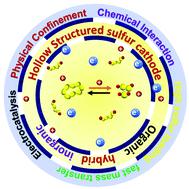当前位置:
X-MOL 学术
›
Mater. Chem. Front.
›
论文详情
Our official English website, www.x-mol.net, welcomes your
feedback! (Note: you will need to create a separate account there.)
Recent advances of hollow-structured sulfur cathodes for lithium–sulfur batteries
Materials Chemistry Frontiers ( IF 6.0 ) Pub Date : 2020-06-22 , DOI: 10.1039/d0qm00303d Xia Huang 1, 2, 3, 4, 5 , Tengfei Qiu 1, 2, 3, 4, 5 , Xinghao Zhang 6, 7, 8, 9, 10 , Lei Wang 6, 8, 10, 11, 12 , Bin Luo 1, 2, 3, 4, 5 , Lianzhou Wang 1, 2, 3, 4, 5
Materials Chemistry Frontiers ( IF 6.0 ) Pub Date : 2020-06-22 , DOI: 10.1039/d0qm00303d Xia Huang 1, 2, 3, 4, 5 , Tengfei Qiu 1, 2, 3, 4, 5 , Xinghao Zhang 6, 7, 8, 9, 10 , Lei Wang 6, 8, 10, 11, 12 , Bin Luo 1, 2, 3, 4, 5 , Lianzhou Wang 1, 2, 3, 4, 5
Affiliation

|
Lithium–sulfur batteries (LSBs) have attracted increasing interest due to their high theoretical energy density and low-cost sulfur. Challenges are still faced in the development of sulfur cathodes, due to the insulating properties of sulfur and lithium sulfide, diffusion of soluble polysulfides and slow redox kinetics of electrochemical conversion reactions. Hollow-structured materials with features such as high specific surface area, tunable pore structure, and controllable morphology and composition have shown great potential to be applied in high performance sulfur cathodes for LSBs. To promote further breakthroughs in this amazing field, this review highlights on the recent advances of hollow-structured sulfur cathodes, with an emphasis on polar inorganic/organic materials that exhibit strong interactions with polysulfides, thus suppressing the unfavourable shuttle effect, and/or efficient catalytic activity towards sulfur conversion reactions, thus improving the redox kinetics. Material design principles, experimental methods and the subsequent effects on electrochemical performance are discussed. The remaining challenges and perspectives associated with sulfur cathode design and battery evaluation are also presented.
中文翻译:

锂硫电池中空结构硫阴极的最新进展
锂硫电池(LSB)由于其较高的理论能量密度和低成本的硫而引起了越来越多的兴趣。由于硫和硫化锂的绝缘特性,可溶性多硫化物的扩散以及电化学转化反应的缓慢氧化还原动力学,在硫阴极的开发中仍然面临挑战。具有高比表面积,可调节的孔结构以及可控的形态和组成等特征的中空结构材料已显示出可用于LSB的高性能硫阴极的巨大潜力。为了促进这一惊人领域的进一步突破,本综述重点介绍了空心结构硫阴极的最新进展,重点是与多硫化物具有强相互作用的极性无机/有机材料,因此抑制了不利的穿梭效应和/或对硫转化反应的有效催化活性,从而改善了氧化还原动力学。讨论了材料设计原理,实验方法以及随后对电化学性能的影响。还介绍了与硫阴极设计和电池评估相关的其余挑战和观点。
更新日期:2020-08-27
中文翻译:

锂硫电池中空结构硫阴极的最新进展
锂硫电池(LSB)由于其较高的理论能量密度和低成本的硫而引起了越来越多的兴趣。由于硫和硫化锂的绝缘特性,可溶性多硫化物的扩散以及电化学转化反应的缓慢氧化还原动力学,在硫阴极的开发中仍然面临挑战。具有高比表面积,可调节的孔结构以及可控的形态和组成等特征的中空结构材料已显示出可用于LSB的高性能硫阴极的巨大潜力。为了促进这一惊人领域的进一步突破,本综述重点介绍了空心结构硫阴极的最新进展,重点是与多硫化物具有强相互作用的极性无机/有机材料,因此抑制了不利的穿梭效应和/或对硫转化反应的有效催化活性,从而改善了氧化还原动力学。讨论了材料设计原理,实验方法以及随后对电化学性能的影响。还介绍了与硫阴极设计和电池评估相关的其余挑战和观点。











































 京公网安备 11010802027423号
京公网安备 11010802027423号